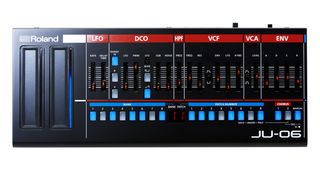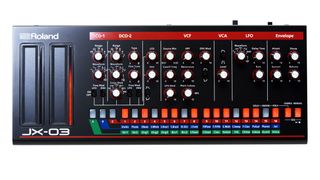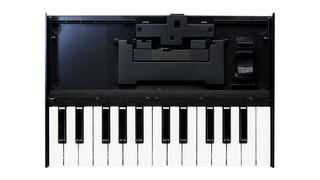Roland Boutique: new Juno, Jupiter and JX synths confirmed
JP-08, JU-08 and JX-03 get their official unveiling

History repeating
The teaser campaign for Roland's new 'Boutique' range of synths was brought to a rather abrupt halt when a retailer released images and specs last week, but only now have the products been officially confirmed.
As expected, we have the JP-08, JU-06 and JX-03 to look forward to, which are inspired by the Jupiter-8, Juno-106 and JX-3P respectively.
The synth engines are powered by the same Analog Circuit Behaviour (ACB) technology as the instruments in Roland's Aira range, so we'd be surprised if these synths don't deliver a pretty close approximation of the originals' sound, and there's a strong emphasis on hands-on control.
Of course, there will be those who complain that they're digital, but if you want analogue, Roland is at least now providing it elsewhere in its JD-X products.
Perhaps the bigger question is whether these synths will just feel like 'Airas in disguise'; indeed, some will ask why Roland needed to invent another brand in order to release them. System-1 owners will no doubt be wondering why they couldn't just have had Jupiter, Juno and JX Plug-Outs, while others will want to know if we're likely to get VST/AU versions any time soon.
What's more, the Boutique name is curious - with their battery-powering option and built-in speakers, these appear to be mainstream products rather than curios that will have limited appeal. That said, we are told that they're 'limited edition', which suggests that they're not going to be on sale forever.
One thing that is definitely quirky here is the optional mini keyboard, the K-25m. Some will balk at the fact that they have to pay extra to create a playable self-contained instrument, while others will be pleased that they're not being charged for built-in mini keys that they don't want and can instead plug in their MIDI controller of choice.
Click through the gallery to find out more about each Roland Boutique model - we'll have more for you when we've had a chance to play them.
It looks like prices are £255/$299 each for the JX-03 and JU-06, and £329/$399 for the JP-08. The K-25m costs £85/$99. All the products should be shipping this month.

JP-08
There's been a lot of talk about Mars this week, but if you're a synth fan, Jupiter is where it's at.
The JP-08 takes inspiration from the iconic Jupiter-8, promising the same sound and putting the focus on hands-on control.
It's actually only a 4-voice module, though you can chain two units together to create an 8-voice synth. What's more, it goes beyond the original by offering additional LFOs and expanded VCO range.
Features
- Ultra-compact recreation of the iconic Jupiter-8 synthesizer
- Retains the feel, sound, character and user interface of the original
- 36 of the original synth parameters controllable from the front panel
- Adds several additions not found on the original Jupiter-8, including extra waveforms, expanded VCO range
- Chain mode allows two JP-08 to function as one 8-voice module
- Highly portable for mobile music making
- High-quality construction with metal front panel
- Dual ribbon controllers for pitch bend, modulation, and sound preview
- Battery-operated (4xAA) or USB powered
- 24 bit / 44.1 kHz stereo IN/OUT USB audio interface
- Built-in 0.5W mini-speaker for instant enjoyment
- Compatible with optional K-25m keyboard unit

JU-06
Released in 1984, the Juno-106 was a classic analogue polysynth, and it now has a distant, rather more compact cousin.
23 of the synth's original parameters are adjustable on the 4-voice JU-06's front panel, and there's now a faster LFO and a continuously-variable high-pass filter.
Features
- Ultra-compact recreation of the iconic Juno-106 synthesizer
- Retains the feel, sound character and user interface of the original
- 23 of the original synth parameters controllable from the front panel
- Adds several additions not found on the original Juno-106, including a faster LFO and
- continuously variable HPF
- Chain mode allows two JU-06 to function as one 8-voice module
- Highly portable for mobile music making
- High-quality construction with metal front panel
- Dual ribbon controllers for pitch bend, modulation, and sound preview
- Battery-operated (4xAA) or USB powered
- 24 bit / 44.1 kHz stereo IN/OUT USB audio interface
- Built-in 0.5W mini-speaker for instant enjoyment
- Compatible with optional K-25m keyboard unit

JX-03
The JX-3P synth, from 1983, had an interface that was button based, but throw the optional PG-200 controller into the mix and suddenly you had 24 rotary knobs to fiddle with as well.
You get all of these on the JX-03, the JX-3P's spiritual successor, as well as new waveforms, expanded DCO range and cross-modulation options.
Features
- Ultra-compact recreation of the iconic JX-3P synthesizer
- Retains the feel, sound character and user interface of the original
- Front panel includes all 24 knobs from the original PG-200 controller
- Adds several updates not found on the original JX-3P, including extra waveforms for
- the LFO and both DCOs, along with extended DCO range
- Chain mode allows two JX-03 to function as one 8-voice module
- Highly portable for mobile music making
- High-quality construction with metal front panel
- Dual ribbon controllers for pitch bend, modulation, and sound preview
- Battery-operated (4xAA) or USB powered
- 24 bit / 44.1 kHz stereo IN/OUT USB audio interface
- Built-in 0.5W mini-speaker for instant enjoyment
- Compatible with optional K-25m mini-keyboard

K-25m keyboard
Although each of the Roland Boutique modules can operate standalone, they can also be docked into this portable 25-note keyboard (one at a time, that is).
The K-25m's mini keys are velocity-sensitive, and modules can be tilted in two different positions, or laid completely flat.
Features
- 25-note velocity sensitive keyboard for use with Roland Boutique modules
- Three-position stand tilts the module for better viewing angle – also lays flat
- High-quality keyboard construction
- Transforms Roland boutique module into highly portable music making tool

I’m the Deputy Editor of MusicRadar, having worked on the site since its launch in 2007. I previously spent eight years working on our sister magazine, Computer Music. I’ve been playing the piano, gigging in bands and failing to finish tracks at home for more than 30 years, 24 of which I’ve also spent writing about music and the ever-changing technology used to make it.











